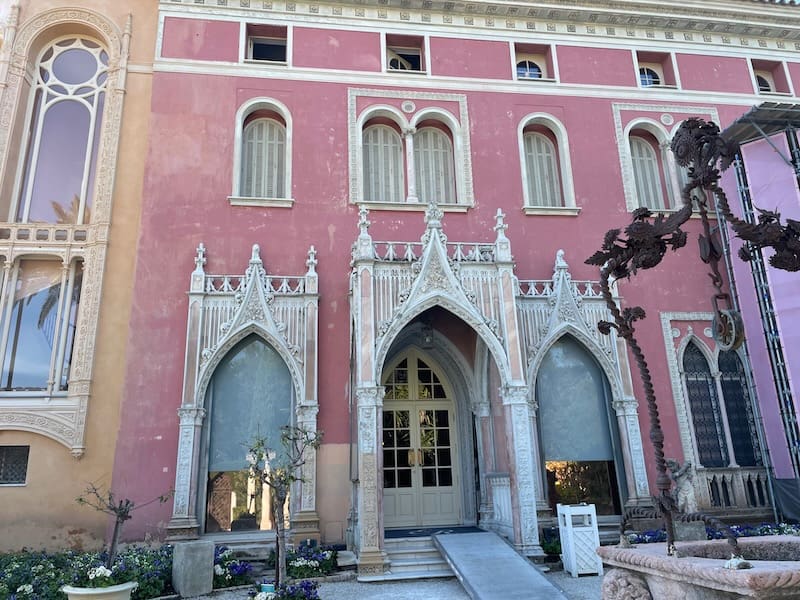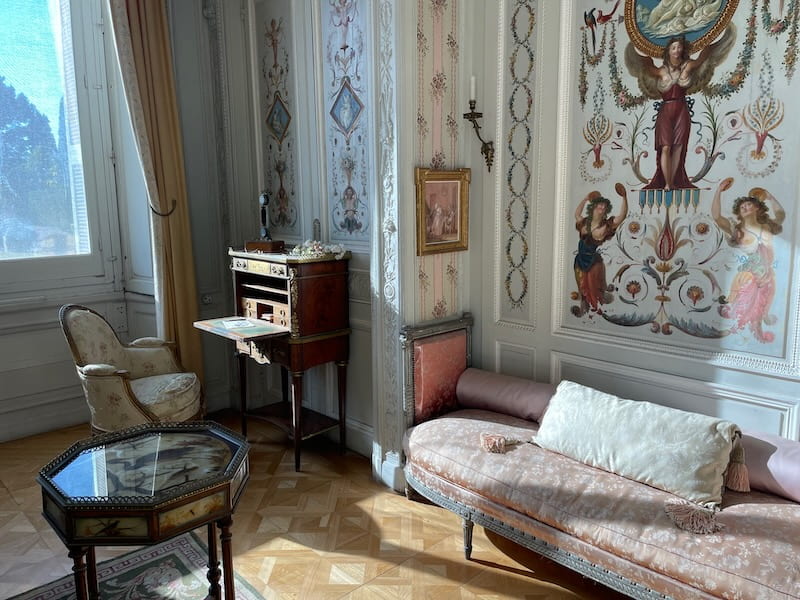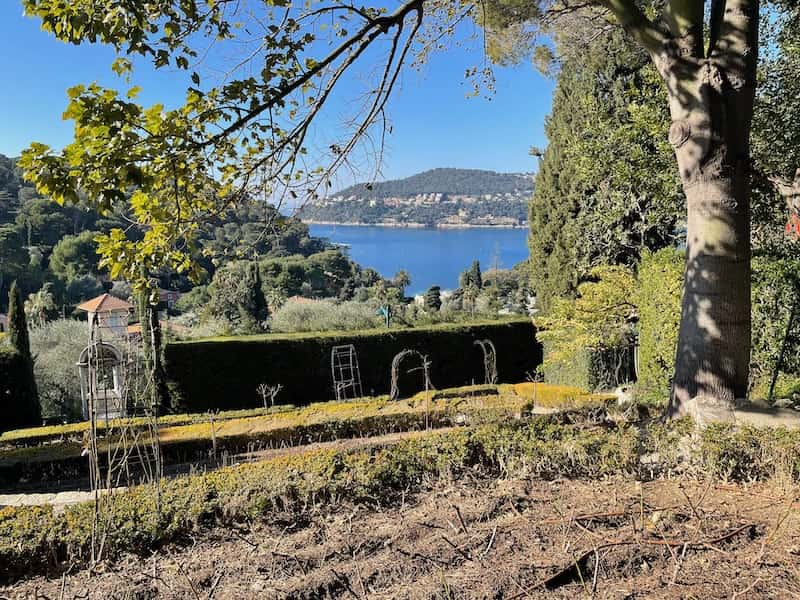Unsure about your French table manners? Click Here to download > > How to avoid these 10 food etiquette mistakes !
- Home ›
- Destinations ›
- Southern France ›
- Villa Ephrussi
The Baroness, The Gigolo, And The Villa Ephrussi de Rothschild
Published 10 September 2023 by Leyla Alyanak
Drift through a perfect example of the Belle Epoque on the French Riviera at the Villa Ephrussi de Rothschild
If it hadn’t been for the gigolo, the baroness might not have built the villa.
He was Maurice Ephrussi, a banker of Russian origin.
She was Baroness Charlotte Béatrice de Rothschild, a socialite and art collector.
As for the early 1900s villa, she built it after ending her unhappy marriage.
If his name, Ephrussi, is on the villa, it is not her fault.
NOTE: Pages on this site may contain affiliate links, which bring in a small commission at no cost to you.
The first time I saw Villa Ephrussi de Rothschild was a few years ago in a photograph, and the vision stayed with me: the delicate pink façade, the multi-hued flowers, the dancing fountains – one of those magical places straight from a Hollywood movie.
Finally, years later, I visited. It was February, I had just completed the Mimosa Route along the Riviera. Frebruary is not ideal for garden visits, yet this one was perfect.
Not everything was in bloom, but what a setting!

Villa Ephrussi de Rothschild, an era in the making
Opulence. Elegance. Overdone. Palazzo. Renaissance.
So many words come to mind when picturing this villa, and each fits.
The villa sits between Nice and Monaco on the narrowest part of the Saint-Jean-Cap-Ferrat peninsula, one of the most beautiful spots in the south of France.
For those of us without the means to build our own palazzo on the Mediterranean Sea, spending a few hours here will get us a little closer.
The Baroness
Béatrice was born into the Rothschild banking dynasty and grew up surrounded by beauty and wealth.
Her father, in one of those dynastic match-making moves, married her off at 19 to Maurice Ephrussi, a banker of Russian origin who shared her passion for beauty, art and architecture, stuffing their sumptuous homes with rare objects.
What he didn’t share was her sense of propriety or loyalty.
Maurice was a womanizer, and his gambling debts were so huge they even made the Rothschilds shudder. Worse, he infected his wife with a sexually transmitted disease, preventing her from ever having children.
It took 21 years, but a divorce was finally agreed, with Béatrice starting a new, independent chapter of her life. Her father had died, leaving her a fortune, and she was divorced, so she wouldn't have to share it.
Having fallen in love with the French Riviera when visiting the Villa Kerylos in nearby Beaulieu-sur-Mer, she decided she wanted her own villa nearby. She successfully bid for a plot of land so spectacular it was being eyed by the King of Belgium, and set out to find an architect.
The building
 Villa Ephrussi de Rothschild, seen from the front entrance
Villa Ephrussi de Rothschild, seen from the front entrance And here, seen from the back, the most frequent view
And here, seen from the back, the most frequent viewVilla Kerylos, which had so impressed her, was a monument to Ancient Greece. Baroness Béatrice Ephrussi de Rothschild would go one better and build a Venetian-style palazzo.
Both villas would survive to this day, showcases of the Belle Epoque.
It wasn’t an easy build and took five years because she kept tinkering with the design.

She would have a hand in it all, from the precious objects which are still on display, to the magnificent gardens people come from far away to see.
Nor was Béatrice just any collector: she was a connoisseur of fine art and was known for her wide-ranging tastes and discernment. In fact, she was a fine art super-shopper, who didn’t have to go to shops − they would come to her. Dealers would bring their art and furniture to the train station at Beaulieu, and she would hand-pick what she wanted.
Many of those purchases still adorn the villa, an echo of her taste. Others were dispersed to different houses − the Villa Ephrussi de Rothschild was not the only home whose aesthetic standard she had to preserve (she did, after all, own more than one property).
It would become her winter home, which may explain why the beautiful gardens were dazzling even during my February visit: she made sure she had plenty of beauty around her, whatever the season. Sadly, though, she wouldn’t be in residence often…
The revival
Béatrice died of tuberculosis at the age of 69 in 1934, and willed her art collection to the Academy of Fine Arts of the Institut de France. She had wanted it turned into a museum with a lived-in feel, and that’s exactly what happened, but the museum stayed open only briefly, shutting with the outbreak of World War II.
During the war, the house was looted and the gardens left to fend for themselves, overgrown and weedy.
After a few administrative sashays and false starts with other managers, the Paris Academy of Fine Arts reclaimed the villa’s management, revived the gardens, painted the façade pink (Béatrice had originally chosen ochre) and changed its name to Villa Ephrussi de Rothschild from the original Villa Île-de-France that had been her choice.
If Béatrice were alive today, she would probably feel insulted by the change. It ended up honoring a man who had brought her only dishonor, and who had never even visited the villa, built after their divorce.
Inside the Villa
It was and still is a beautiful house, and while the pink villa may fly in the face of Béatrice’s original wishes, it does complement a lot of the pink Verona marble inside.

The villa’s 15 magnificent rooms served a multitude of purposes, from the covered patio where Béatrice greeted her guests to the large living room with woodwork recovered from the Hotel Crillon in Paris to the Tiepolo painting on the ceiling.


Inside, the villa is a kaleidoscope, a jumble of different styles and colors and eras, from Moorish balconies to 18th century furniture to the exquisite porcelain collections Vincennes, Sèvres and Meissen − and the Aubusson carpet on the floor. Each space has its own character, from Venetian to Chinese to French Directoire. You won't be bored.



While the ensembles are eclectic, there’s a harmony to that diversity and it is best to look at each room three times: first, in its entirety, to understand its purpose and the thinking behind it; second, as a piece of the puzzle that fits into the villa's greater scheme; and third, in great detail, to admire the exquisite works of art scattered here and there, daring you to find them.


Béatrice surrounded herself with big names: Marie-Antoinette, Napoleon, Madame de Pompadour, Louis XV and XVI… each played a role in her home, part of a static theater set designed to transport you away from the present. This was, after all, her dream house.
The (9) themed gardens
Béatrice’s gardens are at least as famous as her house, perhaps even more so.
If I've placed the "9" in brackets, it's because I'm missing a garden. Everyone says there are nine gardens, including the villa's own literature. Yet counting them, I can come up with only eight.
I've counted several times, but I'm still a garden short. I'd be pleased to find that missing garden...
Each of her gardens reflects a distinct mood and is designed to bloom at different times of year so that even in winter, there is plenty to see.
As you make your way around, remember to look outwards towards the sea, towards Beaulieu-sur-Mer and Villefranche-sur-Mer. It would be a shame to miss these spectacular views.
The French Garden
Béatrice took particular pride in this garden, which is shaped like a shipdeck and fed by plenty of water.
Look upward from the back of the villa and your eyes will take you up, up, up until you reach the Temple of Love. The prow. The summit. A sort of nautical fantasy. It couldn’t be more Italian Renaissance…
And dancing fountains, for the wide-eyed child in you.
The Spanish Garden
A grotto, a pergola, a canal. Pomegranate and olive trees. I almost expected a flamenco dancer to erupt from behind the honeysuckle and break into soulful song. Seriously, this Andalusian garden is full of promise, at least in February. I suspect the promise begins to deliver around March.

The Florentine Garden
As its name implies, this is a cypress-bordered corner of Renaissance grandeur, with a grand horseshoe staircase and a garden planted during the Belle Epoque. This is one garden I can’t really describe – it is stunning, and luscious, and you’ll have to see it for yourself.

The Lapidary Garden
This is the Stone Garden, an easy place to lose yourself, among sculptures salvaged from different times and places and wildly flowering azaleas and hydrangeas and rhododendrons – and a gargoyle or two. In summer, expect camelias, plenty of camelias.

The Japanese Garden
This is a little island of serenity in a garden of exuberance, with its Zen-like stone artistry and a waterfall that trickles into a koi pond, a place for meditation and peace. This garden was once home to an aviary – Béatrice loved birds. Now, it’s a quiet place.

The Exotic Garden
Once known as the Mexican Garden (and you’ll immediately see why), these giant cacti and succulents look completely out of place here, hence the “exotic” label. A walk along its paths will absolutely transport you to another part of the world.

The Rose Garden
The rose garden is the one single reason I’d return during another season. I have roses at home (not of the same caliber, of course) and I know just how fragrant and wild they can be. In winter, though...

The Provençal Garden
This one is classic Provence, as its name implies. It resembles the region, with olive trees and lavender and aromatic plants. I'm not quite sure why Béatrice felt the need for this garden – this was, after all, the scenery that filled the entire region.
Getting to the Villa Ephrussi de Rothschild
The villa and its gardens are now classified as a historical monument, and the gardens are listed as Notable Gardens of France, one of the country's many tourism labels, by the French Ministry of Culture. Not everyone loves this ornate style of building and decoration, but even if you don’t, some places are worth seeing. This is one of them.

If you’re driving, all I can say is – get there early! The parking lot is tiny, and you’ll have to drive to the end and perform a U-turn if it’s full… and wait. Or drive back into Saint-Jean-Cap-Ferrat, park there, and use the valet service.
If you’re coming by bus from Nice, take bus line #15 (former line #81), get off at “Passable-Rothschild” and follow the signs (you'll be right at the driveway entrance). You can also take bus line #100 and get off at “Pont Saint Jean”, but you'll have a bit of a hike up to the villa.
You could come by train to Beaulieu-sur-Mer, but I don’t recommend it unless it’s cool outside and you're ready for a hearty uphill walk.
At the villa, you might want to pick up the audio guide for more detailed explanations of what you’re about to see. You can get your admission ticket for the Villa et Jardins Ephrussi de Rothschild here.
Villa Ephrussi de Rothschild FAQ
Can you rent the Villa Ephrussi?
Can you rent the Villa Ephrussi?
You can even get married there! It will cost you a small fortune but the villa can be privatized for your event.
Is there anything nearby?
Is there anything nearby?
This is one of the most crowded spots in France. Monte-Carlo and Nice are both nearby, as are the villages of Beaulieu-sur-Mer (and its Villa Kérylos) and the delightful Villefranche-sur-Mer.
Who lived at the Villa Ephrussi?
Who lived at the Villa Ephrussi?
The Villa only had one official resident – Baroness Béatrice Ephrussi de Rothschild, who built the villa.
How to get to the Villa Ephrussi de Rothschild from Nice?
How to get to the Villa Ephrussi de Rothschild from Nice?
The easiest is to take the #15 bus and get off at Passable-Rothschild. The stop is near the driveway entrance and it's a short walk to the villa.
Where is the Villa Ephrussi de Rothschild?
Where is the Villa Ephrussi de Rothschild?
The villa is on the French Riviera, between Nice and Monaco, on the Saint-Jean-Cap-Ferrat peninsula.
One last thing...
The villa is only one of many arresting sights along the French Riviera – it’s hard to know where to start when visiting this region. To make your planning easier, here are my top 10 picks for a first-time visit to the Côte d’Azur, all places I’ve visited and can recommend.
Did you enjoy this article? I'd love if you shared it!
 |
 |


